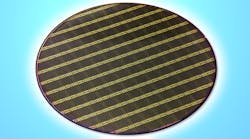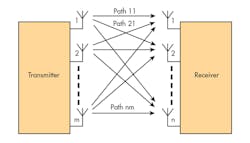This file type includes high resolution graphics and schematics when applicable.
Modern wireless systems have long depended on monolithic microwave integrated circuits (MMICs) and are increasingly relying on the use of multiple-input, multiple-output (MIMO) antenna techniques. As much as these abbreviations seem similar, what exactly is each technology and what roles do each play in a wireless system? Knowing the differences between MMICs and MIMO systems can help avoid confusion when assembling the components for a modern wireless communications system.
MMICs are integrated circuits (ICs), designed for use at microwave frequencies and, occasionally, as high as millimeter-wave frequencies. They were originally fabricated solely on gallium-arsenide (GaAs) semiconductor wafers. Now, though they are based on a wide range of semiconductor materials, including silicon (Si), indium phosphide (InP), silicon germanium (SiGe), and, increasingly, gallium nitride (GaN) for its capabilities of operating at high voltages and high power levels at microwave frequencies (as a basis for microwave amplification and for transmitter and transceiver circuits).
MMICs comprise a number of different high-frequency components on the same chip, supplied in semiconductor die form or in a package, such as a surface-mount-technology (SMT) package for ease of mounting on a printed circuit board. A MMIC can be a passive component, such as a filter, or an active component, such as an amplifier, rather than a transistor in a similarly small package.
As an example, the model CMD233C4 from Custom MMIC is a distributed amplifier in a low-profile package (Fig. 1) fabricated on GaAs semiconductor substrate material. It is extremely broadband, operating from 2 to 18 GHz with more than 9-dB small-signal gain, 4.5-dB noise figure, and +20.5-dBm output power at 1-dB compression. The MMIC is impedance-matched to 50 Ω and powered by a single bias supply of +3 to +6 V dc.
RF/microwave MMICs are available from a large number of suppliers, in die and packaged formats, which simplifies the task of adding component functions while shrinking the overall size of a system design. MMICs can be mass-produced from large semiconductor wafers (Fig. 2) and screened through automated testing to maintain proportionally lower cost for each component than the equivalent cost of each of the discrete component functions they replace.
While GaAs was once the semiconductor wafer material of choice for microwave MMICs, more work at present is being done at high frequencies on GaN wafers (at least for power amplifiers) because of the material’s enhanced power capabilities compared to GaAs. Many military contractors, such as Northrop Grumman Corp. (www.northropgrumman.com), maintain their own GaN and GaAs wafer/semiconductor foundries as a source of high-frequency semiconductors.
In addition, commercial semiconductor foundries offer wafers and fabrication services that enable customers to submit design files in software to fabricate MMICs or discrete devices within the limits of a particular commercial semiconductor foundry’s design guidelines. GaN is currently a widely accepted starting material for high-frequency MMICs, with many device designers in quest of filling one major gap between GaN and GaAs, and that is for a truly low-noise amplifier (LNA) based on GaN material.
Boosting Capacity with MIMO
MIMO antennas are similar to MMICs in that they integrate a number of antennas into a single package (Fig. 2). These antennas take advantage of multipath propagation to improve the performance and capacity of a wireless communications system. Prior to the use of MIMO techniques, multipath effects were never considered a good thing. Signal multipath is caused by transmitted signals bouncing off objects between a transmit antenna and a receive antenna, such as buildings, towers, bridges, and any object with sufficient mass and material type to deflect electromagnetic (EM) energy.
Legacy wireless communications systems have used what are known as single-input, single-output (SISO) antenna configurations. MIMO approaches employ multiple transmit and receive antennas or antenna elements to send signals along a number of different propagation paths (Fig. 2) rather than a single signal path and, in the process, enable increased data rates for a given frequency and bandwidth.
MIMO methods can increase channel capacity as a function of the increasing number of antenna elements or boost performance in terms of signal-to-noise ratio (SNR) of a transmitter-receiver combination. Quite simply, more antennas in a MIMO system, such as a 4 × 4 MIMO system, with four transmit and four receive antennas, versus a 2 × 2 MIMO system, with two transmit and two receive antennas, means faster data rates and greater capacity.
MIMO techniques were developed in response to the ever-increasing number of wireless communications subscribers and limited amount of available bandwidth. MIMO is employed in a number of mobile communications standards, including IEEE 802.11 (Wi-Fi), IEEE 802.16 (WiMAX), Third-Generation (3G) wireless systems, and Fourth-Generation (4G) wireless systems, including Long Term Evolution (LTE) systems.
MIMO may be implemented in the form of polarization diversity systems, where antennas use adjustable feed systems to achieve dual polarization, such as vertical and horizontal polarization or X-polarization (with –45 deg. and +45 deg. polarization). Different diversity modes may also be used with MIMO antennas.
Diversity modes typically used in MIMO systems include time diversity, space diversity, and frequency diversity. In time diversity, data is transmitted at different times, using different time slots and different channel coding. In space diversity, antennas are positioned in different physical positions in order to make use of terrestrial characteristics and different radio paths available in a particular location. A reference signal (RS) is used in many MIMO configurations to allow for measurements of the spatial channel properties and facilitate coherent demodulation at the terminal. It can be an RS for a specific terminal or a common RS (CRS) that is shared among a group of terminals.
Spatial multiplexing may also be used in MIMO systems to increase system capacity. With spatial multiplexing, multiple spatial streams are sent through multiple transmit antennas; the spatial streams are separated at the receiver’s multiple antennas by means of spatial signal processing.
In frequency diversity, information is communicated using different frequencies, such as the different channels on a commercial broadcast radio. It may also be implemented by means of frequency-agility techniques, such as frequency hopping or spread-spectrum communications, to divide transmitted data among available frequencies and bandwidth, as well as minimize the effects of interference and enhance communications security.
This file type includes high resolution graphics and schematics when applicable.




